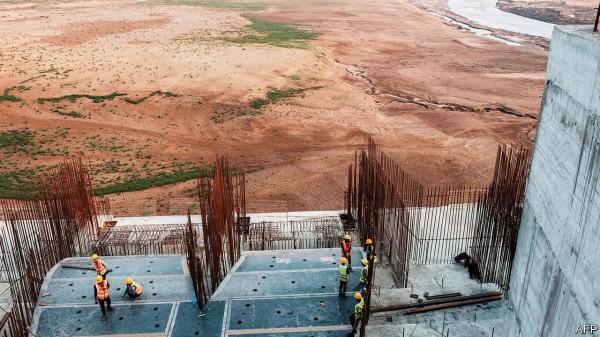Go Back
THE BITTER DISPUTE OVER AFRICA’S LARGEST DAM
Egypt, Ethiopia
and Sudan are struggling to share water.
For biruk negafh, as for millions of Ethiopians, the summer
rains may bring the climax of a decade’s work. As a high-school student in 2011
he bought 100-birr bonds (then worth $6 each) to help finance the Grand
Ethiopian Renaissance Dam, a giant edifice that would span the Blue Nile, the
main tributary of the Nile river (see map). At university he donated to
fundraisers for the project. Now, like almost all Ethiopians, he eagerly awaits
the day—perhaps weeks away—when Ethiopia begins to fill the reservoir. “It’s a
national victory,” he says.
Half a century in the making, the hydro-electric dam is
Africa’s largest, with a reservoir able to hold 74bn cubic metres of water,
more than the volume of the entire Blue Nile. Once filled it should produce
6,000 megawatts of electricity, double Ethiopia’s current power supply. Millions
of people could be connected to the grid for the first time. More than an
engineering project, it is a source of national pride.
For Egypt, however, it seems a source of national danger.
Over 90% of the country’s 100m people live along the Nile or in its vast delta.
The river, long seen as an Egyptian birthright, supplies most of their water.
They fear the dam will choke it off. Pro-regime pundits, not known for their subtlety,
have urged the army to blow it up.
Both sides have tried diplomacy, but years of talks failed to
produce a deal on how Ethiopia would fill and operate the dam. The African
Union tried to mediate, as did America earlier this year. Now a deadline looms:
Ethiopia wants to start filling the reservoir during this summer’s rainy
season. On June 26th, after another round of talks, Egypt, Ethiopia and Sudan
pledged to reach a deal within two weeks. Ethiopia agreed not to start filling
the dam during that period.
Diplomats say most of the issues are resolved. But the
outstanding one is big: how to handle a drought. Egypt wants Ethiopia to
promise to release certain amounts of water to top up the Nile. But Ethiopia is
loath to “owe” water to downstream countries or to drain the reservoir so much
that electric output suffers. It wants a broader deal between all riparian
states, including those on the White Nile, which flows out of Lake Victoria
down through Uganda and Sudan.
Even if talks fail and Ethiopia starts filling without a
deal, Egyptians will not find their taps dry. There is enough water in the
reservoir behind Egypt’s Aswan High Dam to make up for any shortfall this year.
But the mood in both countries is toxic. Egyptians have cast Ethiopia as a
thief bent on drying up their country. In Ethiopia, meanwhile, Egypt is
portrayed as a neocolonial power trampling on national sovereignty. The outcome
of the talks will have political consequences in both countries, and perhaps
push them to the brink of conflict—at a time when Egypt is already
contemplating involvement in a war in Libya.
Mooted first by Emperor Haile Selassie in the 1960s,
Ethiopia’s grand dam became a reality and a national obsession under Meles
Zenawi, the longtime prime minister who ruled until 2012. His political
masterstroke was asking Ethiopians to finance it through donations and the
purchase of low-denomination bonds. (The World Bank and private investors were
unwilling to put up the cash.) Almost every Ethiopian became a stakeholder.
Most contributed voluntarily, but there was always an element of coercion. Civil
servants had to donate a month’s salary at the start. Local banks and other
businesses were expected to buy bonds worth millions of birr.
When he took office in 2018, Abiy Ahmed, Ethiopia’s current
prime minister, criticised the dam as a project “used for political expediency”
and warned it could take another decade to finish, statements seen as an attack
on his predecessors. Some questioned his commitment. The cloud grew heavier
after the death in 2018, officially by suicide, of the project’s chief engineer.
At a meeting with Abdel-Fattah al-Sisi in Cairo, Abiy reportedly shocked
advisers by discarding a planned speech and telling the Egyptian president: “I
swear to God, we will never harm you.”
Two years on, Egyptians complain that Abiy has reverted to type.
He is “inflexible”, says an Egyptian diplomat. Ethiopia is gripped by jingoism
over perhaps the only issue that unites citizens of all ethnicities. On
state tv broadcasters compare the dam to the battle of Adwa in 1896,
when Ethiopians came together to defeat the Italians. Teddy Afro, perhaps the
country’s most famous pop singer, released a song about the Nile on June 29th.
Delaying filling would be politically risky for Abiy.
Nor does Mr Sisi have much room to compromise. Egypt is
already short of water. The un sets the threshold for scarcity at an
annual 1,000 cubic metres per person. In 2018 Egyptians had just 570 cubic
metres; even without the dam, that could drop to 500 cubic metres within five
years. Ethiopia has blocked proper studies of how the dam will affect
downstream countries.
The shortage is partly Egypt’s own fault. It uses almost 80%
of its water, which it subsidises, for agriculture. (In Jordan and Israel, two
nearby countries with limited freshwater resources, the figure is closer to 50%.)
Irrigation canals, most of them decades old, are notoriously ill maintained and
leaky. Farmers grow thirsty crops like bananas, rice and sugar cane, despite
government plans meant to deter the practice. All this for a limited pay-off:
Egypt still imports half its food. Supplies are further pinched by farm
projects in Sudan, where Gulf states have bought large tracts of arable land to
help feed their own people.
For years Egyptian officials failed to take the dam
seriously. Now they face a deadline—and a pile of other problems. Egypt’s
covid-19 outbreak started slowly, but the daily death toll peaked on June 15th
and remains at a high plateau. Economic damage is mounting, too. On June 26th
the imf approved a loan of $5.2bn to Egypt.
Mr Sisi is also nervous about developments on his western
border. Khalifa Haftar, the Egyptian-backed Libyan warlord who last year vowed
to capture Tripoli, beat an ignominious retreat this spring. He was pushed back
after Turkey sent armed drones and Syrian militiamen to support the un-recognised
government in Tripoli.
Egypt sees a Turkish presence next door as a threat.
Relations have grown steadily worse since 2013, when Mr Sisi overthrew Muhammad
Morsi, an Islamist, like Turkey’s president, Recep Tayyip Erdogan. Last month Mr
Sisi said his country had a right to intervene in Libya. He warned the
Turkish-backed forces not to advance past Sirte, a strategic coastal city that
sits near Libya’s main oil-export terminals.
Egypt’s army is wary of foreign wars, a caution that dates back
to its ill-fated intervention in Yemen in the 1960s, which cost tens of
thousands of lives (and left it unprepared to fend off Israel in 1967). Since
then it has largely avoided overseas adventures, save for an unimpressive cameo
in the Gulf war in 1991. Instead it has fought jihadists on the Sinai
peninsula, overthrown a president and built an economic empire that stretches
from luxury hotels to cement. Now Mr Sisi finds himself uncomfortably surveying
crises on two fronts.
Abiy’s position in Ethiopia is hardly more comfortable.
Rivals at home have seized on his perceived weakness. One brilliant opposition
leader accuses him of offering the dam as a “sacrificial lamb” to foreign
powers. “If he fails to start filling in July, he is in trouble,” says Jawar
Mohammed, an influential activist, who was falsely arrested last month. On June
30th protests erupted after a popular musician from the Oromo ethnic group was
killed, a reminder of how thin the veneer of national unity is. The technical
details of a deal can be worked out, but neither leader has a deep reservoir of
political capital to make it a reality.


